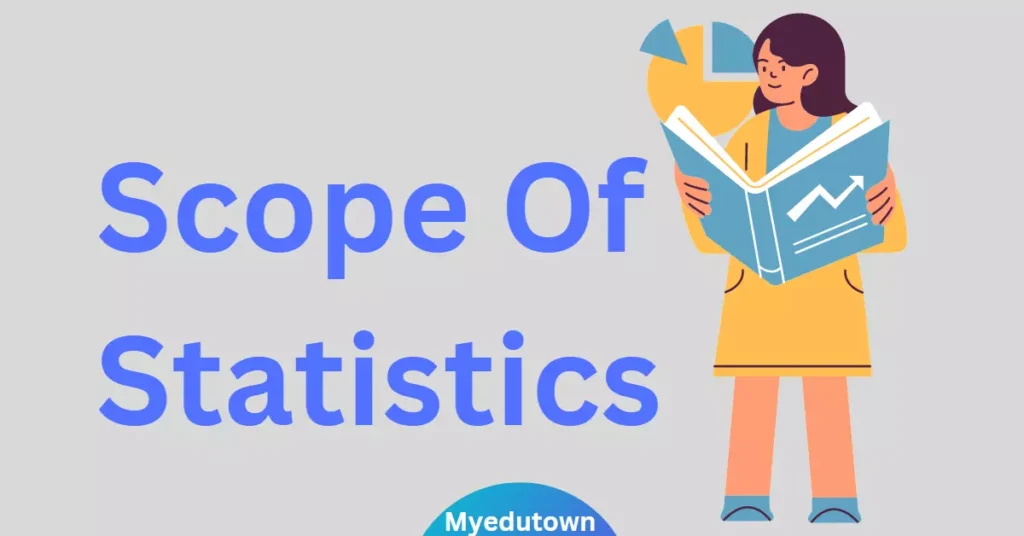Statistics is a powerful tool that is used in a wide variety of fields to analyze data and draw meaningful conclusions. From agriculture to engineering, and from economics to psychology, statistics are used to understand complex systems, identify trends and patterns, and make informed decisions. In this article, we will explore the many scopes of statistics and how it is used to tackle challenges and solve problems in different fields.

What is Statics?
Statistics is a branch of mathematics that deals with the collection, analysis, interpretation, presentation, and organization of data. It is used to describe and summarize large sets of data, and to draw conclusions about the data based on statistical analysis. Statistics is a versatile tool that is used in many different fields, including science, business, and government, to make sense of complex data sets and to inform decision-making.
Scopes of Statistics
1. Agricultural Science
Statistics is used in agricultural science to analyze data on crop yields, soil conditions, and other factors that affect farming. This can help researchers understand how different farming practices and techniques impact the success of crops and livestock. For example, a researcher studying the impact of different fertilizers on crop yields might collect data on the types of fertilizers used, the amounts applied, and the resulting yields. They could then use statistical analysis to determine which fertilizers are most effective at increasing crop yields.
2. Economics
Statistics is an essential tool in economics, as it is used to analyze data on prices, production, and other economic variables. This can help economists understand trends in the economy and make predictions about the future. For example, an economist might use statistical analysis to examine data on unemployment rates, inflation, and gross domestic product (GDP) to understand trends in the economy and make predictions about the future.
3. Education
Statistics is used in education to analyze data on student performance, teacher effectiveness, and other factors that affect learning. This can help educators identify areas of improvement and develop strategies to improve student outcomes. For example, a researcher studying the effectiveness of different teaching methods might collect data on student test scores and use statistical analysis to determine which methods lead to the greatest improvements in student performance.
4. Engineering
Engineers use statistics to analyze data on the performance of various materials and systems. This can help them design more efficient and effective products and processes. For example, an engineer might use statistical analysis to examine data on the performance of different materials under various conditions, in order to determine which materials are most suitable for a particular application.

5. Environmental Science
Environmental scientists use statistics to analyze data on air and water quality, climate change, and other environmental issues. This can help them understand the impacts of human activities on the environment and identify ways to mitigate these impacts. For example, an environmental scientist might use statistical analysis to examine data on air quality in a city and determine whether certain factors, such as traffic levels or industrial emissions, are correlated with higher levels of pollution.
6. Medicine and Health
Statistics is a crucial tool in the field of medicine and health, as it is used to analyze data on the effectiveness of different treatments, the prevalence of diseases, and other health-related issues. This can help healthcare professionals make more informed decisions about patient care. For example, a medical researcher might use statistical analysis to examine data on the effectiveness of different medications in treating a particular disease, in order to determine which medication is most effective.
Read Similar: Scope of Statistics in Nursing
7. Political Science
Political scientists use statistics to analyze data on voting patterns, public opinion, and other political phenomena. This can help them understand the factors that shape political decision-making and predict the outcomes of elections. For example, a political scientist might use statistical analysis to examine data on voting patterns in different states and determine which factors, such as economic conditions or demographic characteristics, are correlated with higher or lower voter turnout.
8. Psychology
Psychologists use statistics to analyze data on human behavior, cognition, and emotions. This can help them understand the underlying causes of psychological disorders and develop effective treatments. For example, a psychologist might use statistical analysis to examine data on the relationship between different personality traits and mental health outcomes, in order to better understand the factors that contribute to mental health problems.
9. Sociology
Sociologists use statistics to analyze data on social relationships, cultural practices, and other social phenomena. This can help them understand the patterns and trends that shape society. For example, a sociologist might use statistical analysis to examine data on crime rates in different neighborhoods and determine whether certain factors, such as poverty levels or social cohesion, are correlated with higher or lower crime rates.
10. Biology
Biologists use statistics to analyze data on the behavior and characteristics of living organisms. This can help them understand the mechanisms underlying biological processes and identify ways to address problems such as disease and environmental degradation. For example, a biologist might use statistical analysis to examine data on the behavior of a particular species of animal and determine whether certain factors, such as the availability of food or the presence of predators, are correlated with changes in behavior.
11. Computer Science
Computer scientists use statistics to analyze data on computer performance, security, and other issues. This can help them develop more efficient and effective algorithms and systems. For example, a computer scientist might use statistical analysis to examine data on the performance of a computer system and determine which factors, such as the type of hardware or the software configuration, are correlated with better or worse performance.
12. Business
Businesses use statistics to analyze data on sales, customer behavior, and other factors that impact the success of an organization. This can help them make informed decisions about marketing, finance, and other aspects of their operations. For example, a business might use statistical analysis to examine data on customer satisfaction and determine which factors, such as the quality of products or the level of customer service, are most important to customers.
Do you know : External Recruitment Process
13. Marketing
Marketers use statistics to analyze data on consumer behavior and preferences, as well as the effectiveness of different marketing campaigns. This can help them identify trends and develop strategies to reach their target audience. For example, a marketer might use statistical analysis to examine data on the effectiveness of different advertising campaigns and determine which types of ads are most effective at reaching the target audience.
14. Finance
Financial analysts use statistics to analyze data on investments, market trends, and other financial issues. This can help them make informed decisions about where to allocate resources and identify opportunities for growth. For example, a financial analyst might use statistical analysis to examine data on the performance of different investments and determine which factors, such as the level of risk or the historical return on investment, are correlated with better or worse performance.
15. Sports
Statistics is used in sports to analyze data on player performance, team strategies, and other factors that affect the outcome of games. This can help coaches and analysts understand how to improve their teams’ chances of success. For example, a coach might use statistical analysis to examine data on player performance and determine which factors, such as training regimens or nutrition, are correlated with improved performance.
16. Transportation
Transportation planners use statistics to analyze data on traffic patterns, transportation needs, and other factors that impact the efficiency and effectiveness of transportation systems. This can help them identify ways to improve the transportation network. For example, a transportation planner might use statistical analysis to examine data on traffic patterns and determine which factors, such as the location of roads or the availability of public transportation, are correlated with higher or lower levels of traffic congestion.
17. Zoology
Zoologists use statistics to analyze data on the behavior and characteristics of animals. This can help them understand the factors that impact animal populations and identify ways to protect and conserve these species. For example, a zoologist might use statistical analysis to examine data on the behavior of a particular species of animal and determine whether certain factors, such as the availability of food or the presence of predators, are correlated with changes in behavior.
18. Demography
Demographers use statistics to analyze data on population size, characteristics, and trends. This can help them understand the dynamics of population growth and change, and make predictions about the future. For example, a demographer might use statistical analysis to examine data on population growth and characteristics, such as age structure and fertility rates, in order to make predictions about the future size and composition of a population.
Importance of Statistics
Statistics is a powerful tool that is essential for making sense of the vast amounts of data that are generated in today’s world. From understanding trends in consumer behavior to identifying risk factors for diseases, statistics is used to analyze data and inform decision-making in many different fields. It is a versatile tool that is used to understand complex systems, test hypotheses, and identify patterns and relationships in data. In an increasingly data-driven world, the importance of statistics cannot be overstated. It is a critical skill for anyone who wants to understand and make sense of the data that surrounds us, and it is a valuable asset for anyone who wants to make informed decisions based on evidence and analysis.
Conclusion
In conclusion, the scopes of statistics are vast and varied, and it is used in many different fields to analyze data and inform decision-making. From agriculture to engineering, and from economics to psychology, statistics is a valuable tool for understanding complex systems and identifying trends and patterns. Whether you are a researcher, a business owner, or simply someone who is interested in understanding data, learning more about the scope of statistics can provide you with valuable skills and insights.




